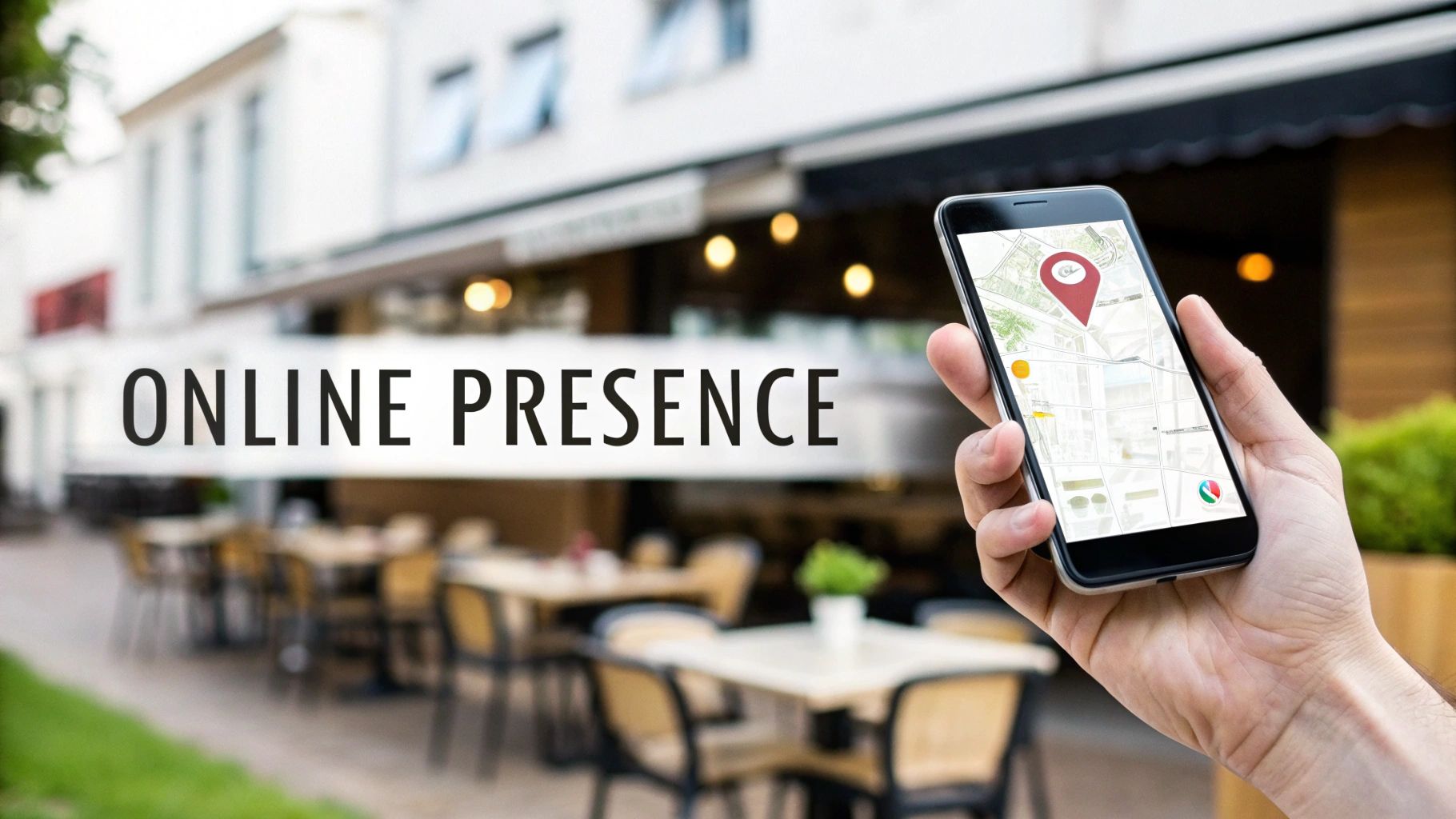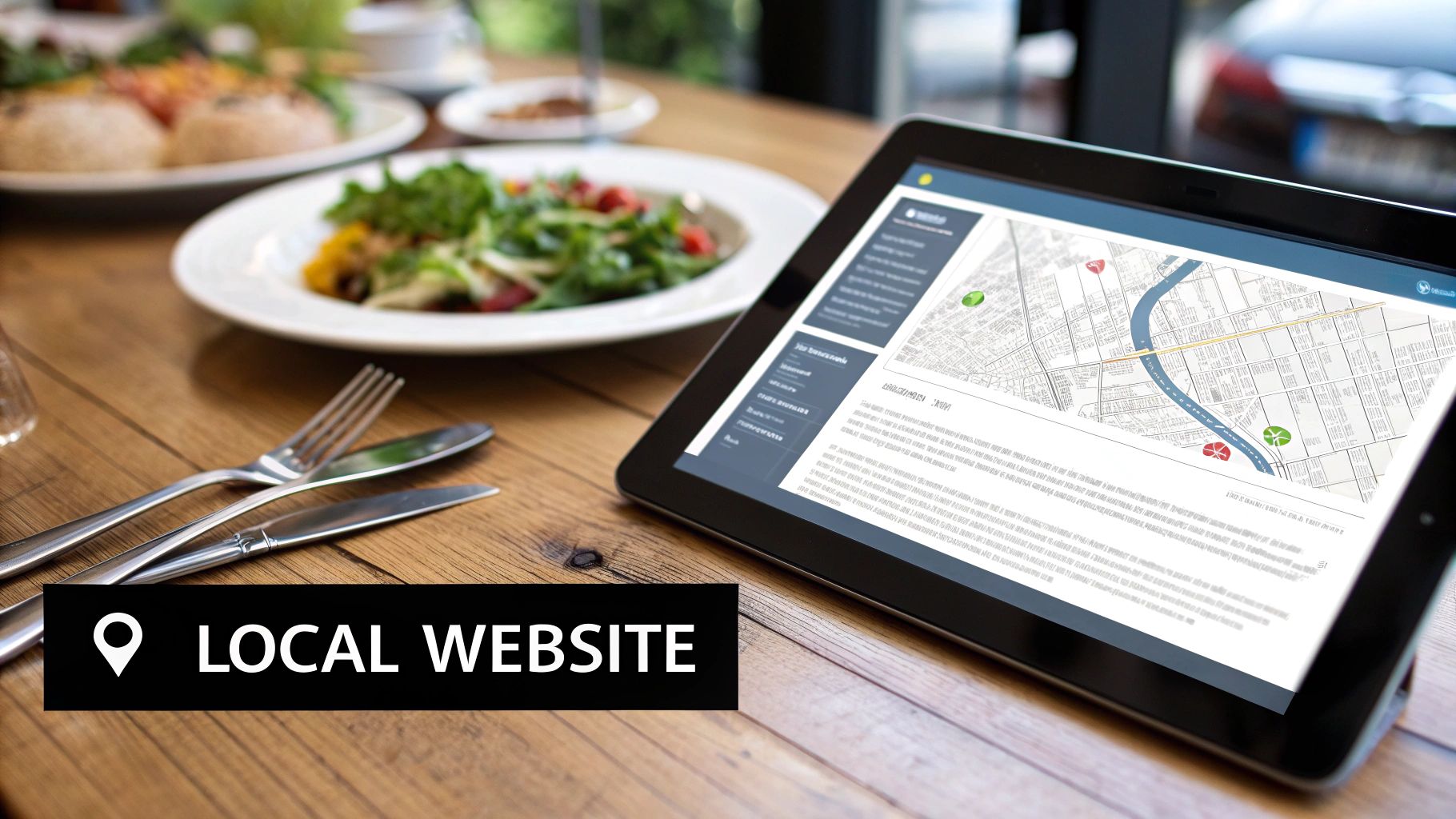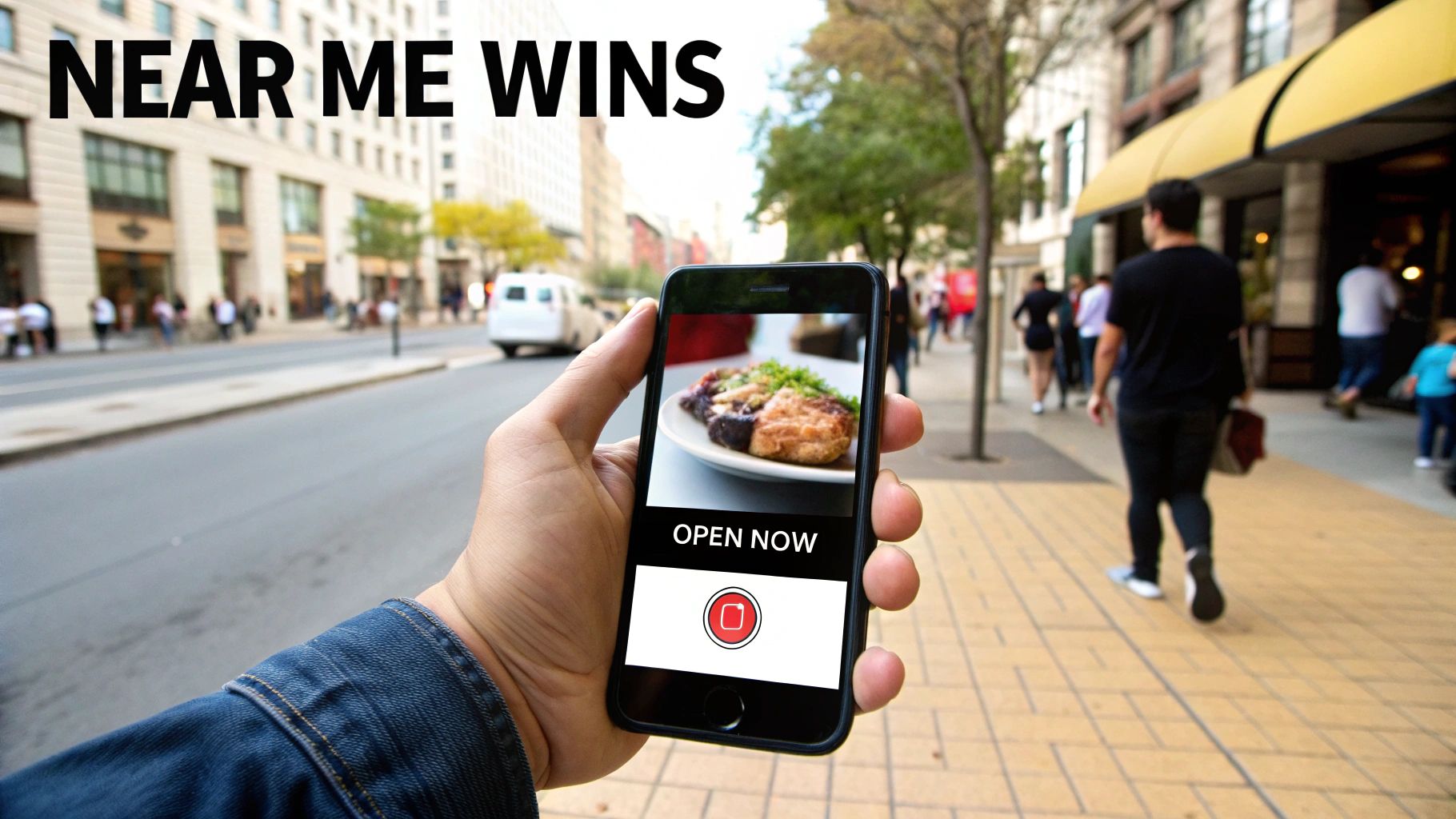
Local SEO for Restaurants Get Found By More Diners
Share
When we talk about local SEO for restaurants, what we’re really talking about is making sure hungry people in your neighborhood find you first. It’s the art and science of getting your restaurant to pop up when someone nearby searches for things like "best tacos near me" or "Italian restaurant open now." To nail this, you need a killer Google Business Profile, a constant flow of great reviews, and a website that works flawlessly on a phone.
Why Your Restaurant's Digital Presence Matters

Let's be real—the modern diner's journey to your tables almost never starts on the sidewalk anymore. It starts on a smartphone. This completely changes the game. Your restaurant's online footprint has become its front door, its curb appeal, and its first impression all rolled into one.
Think about it from your own experience. Before a potential guest ever smells your wood-fired pizza or feels the vibe of your dining room, they’re scrolling through your menu online, checking out photos, and seeing what other people have to say. The numbers don't lie: a whopping 77% of diners check out a restaurant's website before they decide where to eat. If your local SEO game is weak, you're basically invisible to most of the people looking for a meal in your area.
From Kitchen Equipment to Customer Experience
You invest in the best kitchen gear—high-performance charbroilers, commercial ovens, top-of-the-line mixers—because you know it’s essential for creating an amazing product. Local SEO for your restaurant is no different. It’s the background "equipment" you need to make sure people actually discover the incredible food you’re serving. It’s what connects all that hard work in the kitchen to the people who are actively looking for it.
When you get your digital presence right, a few key things happen:
- You grab high-intent customers. You show up in front of people who have their wallets out and are ready to decide where they’re eating tonight.
- You build trust before they even visit. A clean, professional Google profile packed with great reviews and mouth-watering photos tells people you’re legit and sets the right expectations.
- You drive revenue directly. A strong online presence funnels people not just to your physical location but to your online ordering and reservation systems, which directly impacts your bottom line.
Your online presence is the digital handshake that welcomes guests before they even walk in. It’s the very first taste they get of your brand, and a solid local SEO strategy makes sure it's a good one.
At the end of the day, getting local search right isn't just another marketing task to check off a list. It’s a core part of modern hospitality. It’s how you turn those online searchers into regulars who fill your seats.
Master Your Google Business Profile

Think of your Google Business Profile (GBP) as the digital front door to your restaurant. It's often the very first impression a potential diner gets. A sparse, half-finished profile is like a restaurant with a faded sign and dirty windows—it just doesn't inspire confidence.
On the flip side, a fully optimized profile is your most powerful local billboard. It helps you dominate the Google Local Pack and convinces hungry searchers to choose your tables over the competition's. This isn't just about having a listing; it’s a strategic asset that turns a casual search into a reservation or a walk-in customer.
The data backs this up. Businesses with complete and accurate GBP listings are 2.7 times more likely to be seen as reputable by potential customers.
Lock Down Your NAP Consistency
Before you get to the fun stuff like photos and menus, you have to nail the fundamentals. The single most critical piece is your NAP: Name, Address, and Phone Number. These three details must be absolutely identical everywhere they show up online—from your website to Yelp to local food blogs.
Even a tiny discrepancy can cause problems. Listing "St." in one place and "Street" in another, or using both "(555) 123-4567" and "555.123.4567," sends mixed signals to search engines. Google relies on this consistency to confirm your restaurant's legitimacy and location. When the data is messy, it erodes trust and can tank your local search rankings.
Think of your NAP as your restaurant's digital fingerprint. If the prints don't match across different platforms, Google gets suspicious and might show a competitor instead. Make it a rule: one official NAP, used everywhere without exception.
Get Hyper-Specific with Your Categories
Choosing the right business categories is one of the most powerful—and most overlooked—levers you can pull for your restaurant's SEO. Just picking "Restaurant" as your primary category is a massive missed opportunity. Google lets you get incredibly specific, which is exactly what you need to do to connect with diners searching for what you offer.
Are you an Italian spot that specializes in a certain kind of pizza? Don't just pick "Italian Restaurant." Choose "Neapolitan Pizza Restaurant" as your primary category. That one small change can make a huge difference in your visibility for those hyper-local, high-intent searches.
A few more examples to get you thinking:
- Instead of "Mexican Restaurant," try "Taco Restaurant" or "Birria Restaurant."
- Instead of "Cafe," pick "Espresso Bar" or "Breakfast Restaurant."
- Instead of "Bar," choose "Cocktail Bar" or "Wine Bar."
Then, use your secondary categories to fill in the rest of the picture. Add things like "Outdoor Seating," "Brunch Restaurant," or "Late Night Food." The more precise you are, the better Google gets at matching you with the right customers. If you're starting from scratch, you can learn more about adding your business to Google to ensure it’s set up for success right from the beginning.
Craft a Compelling Business Description
Your business description is your elevator pitch. You've got 750 characters to tell your story and convince someone to stop by. Don't just list what you are; explain why people should choose you.
Weave in your keywords naturally. Talk about your signature dishes, the style of your cuisine, and what makes you unique, like "waterfront dining" or "farm-to-table ingredients." This is your chance to sell the entire experience, not just the food.
Just look at the difference.
A weak description: "We are a restaurant in downtown. We serve food and have a bar. Open every day."
A strong description: "Experience authentic, wood-fired Neapolitan pizza in the heart of the Arts District. Our family-owned trattoria uses locally sourced ingredients and a classic Italian recipe to bring you the best slice in town. Perfect for a romantic dinner or a family gathering. Enjoy our curated wine list and spacious patio seating."
The second one paints a picture. It uses relevant keywords ("Neapolitan pizza," "patio seating") and sells an atmosphere, not just a meal.
Leverage Restaurant-Specific Features
Google gives restaurants a whole suite of tools to use within their profiles. Actually using them sends strong signals to Google that you're an active, engaged business, which can give your rankings a nice little boost.
To make sure you've covered all your bases, here's a handy checklist. Go through your profile and tick these off one by one.
Google Business Profile Optimization Checklist for Restaurants
This checklist breaks down the essential tasks for creating a fully optimized GBP that attracts new diners.
| Category | Optimization Task | Why It Matters for Restaurants |
|---|---|---|
| Core Info | Verify and lock down NAP consistency across all platforms. | Builds Google's trust and is a foundational ranking factor for local search. |
| Categories | Select a hyper-specific primary category (e.g., "Sushi Bar"). | Connects you with high-intent diners searching for exactly what you offer. |
| Visuals | Upload high-quality photos of food, interior, exterior, and team. | Photos are a top decision-making factor; they set expectations and drive engagement. |
| Menu & Ordering | Upload your menu directly or link to it on your website. | Allows customers to see your offerings instantly within the search results, reducing friction. |
| Reservations | Integrate a "Reserve a Table" button with your booking platform. | Captures customers at their moment of decision, converting searchers into reservations. |
| Attributes | Add relevant attributes like "Outdoor seating" or "Serves coffee." | Helps you appear in filtered searches (e.g., "restaurants with outdoor seating near me"). |
By methodically working through every section of your Google Business Profile, you’re doing more than just filling out a form. You're building a powerful customer acquisition engine that works for you 24/7, turning hungry searchers into your newest regulars.
Optimizing Your Restaurant Website for Local Search

While your Google Business Profile is your digital billboard, think of your website as your online headquarters. It’s where you control the story, show off your brand’s personality, and ultimately turn curious lookers into paying customers. The two work hand-in-hand: a strong GBP drives people to your site, and a well-tuned site gives Google all the right signals to rank you even higher.
This digital one-two punch is more critical than ever. An eye-opening 90% of diners now research restaurants online before deciding where to eat. Your website is often the very first taste a potential customer gets of your brand. They’re checking menus, looking at photos, and scanning reviews—all before they even think about stepping through your door.
Make Your Website Mobile-First
Before you do anything else, your website has to work flawlessly on a smartphone. Period.
The huge majority of "near me" searches happen on mobile devices. We're talking about hungry people who are out and about, ready to make a decision right now. If they land on your site and have to pinch and zoom just to read your menu, they're gone. They’ve already bounced to a competitor with a site that actually works on their phone.
It's not just about user experience, either. Google uses a "mobile-first" approach for ranking, meaning it primarily judges your site based on its mobile version. A clunky, slow mobile site doesn't just frustrate people; it actively torpedoes your search rankings. A responsive design that automatically adapts to any screen isn't a luxury—it's non-negotiable.
Weave Local Keywords into Your Content
To show up in local searches, you need to talk like your customers search. This means naturally sprinkling location-specific keywords throughout your website. Just think about what a real person would type into Google to find a place like yours.
Instead of just "Gourmet Burgers," you need to get more specific, like "best gourmet burgers in downtown Denver" or "farm-to-table dining in Brooklyn."
Here are the most important places to put these local phrases:
- Homepage: Your main heading should scream what you are and where you are.
- Menu Page: Add some local flavor to your descriptions, like "Our signature Austin-style BBQ brisket."
- Contact/Location Page: This is a goldmine for local keywords. Include your full address, embed a Google Map, and even mention nearby landmarks.
Your website content should answer the two most important questions for a local searcher: "What do you serve?" and "Where are you located?" Make the answers impossible to miss.
For a deeper dive into optimizing your site’s content, explore our detailed guide on what is on-page optimization.
Create Dedicated Location Pages
If you run more than one restaurant, this is a huge one. You need a separate, unique page for each individual location. A generic "Locations" page that just lists addresses is lazy and doesn't give Google enough specific info to rank each spot for its own local searches.
Treat each location page like a mini-homepage for that specific restaurant. It absolutely must include:
- The unique Name, Address, and Phone Number (NAP) for that location.
- Its specific business hours.
- An embedded Google Map pointing to that exact address.
- Photos of that restaurant's interior, exterior, and maybe even the team.
- Unique content about the neighborhood or what makes that particular spot special.
This strategy helps each of your restaurants show up in hyper-local searches like "sushi near the financial district," casting a much wider net to catch new customers.
Demystify Schema Markup for Restaurants
Don't let the term "schema markup" intimidate you. Think of it as a secret language you use to talk directly to search engines. It’s code you add to your site that gives Google structured, easy-to-understand information about your restaurant.
Why bother? Because Google uses this info to create "rich snippets" right in the search results—things like star ratings, hours, and menu highlights that make your listing jump off the page.
For restaurants, this is a secret weapon. You can use schema to explicitly tell Google about your:
- Cuisine type (e.g., Italian, Thai, Vegan)
- Price range
- Accepted payment types
- Hours of operation
- Aggregate star rating from reviews
When Google can easily read this data, it's far more likely to feature your restaurant prominently. It gives you a serious edge over competitors who haven't bothered with this step, making your listing more informative, more clickable, and more likely to drive hungry customers straight to your door.
Building Powerful Local Citations and Backlinks
Your restaurant's reputation isn't just built within your four walls. It's also built all over the web. Think of it as digital word-of-mouth. This authority comes from two main sources: local citations and backlinks. Getting these right tells search engines that you're a legitimate, trusted, and important part of the local scene.
A local citation is any mention of your restaurant's Name, Address, and Phone number (NAP) online. You'll see these pop up on sites like Yelp, TripAdvisor, local food blogs, and countless online business directories. When these details are consistent and accurate across many reputable sites, they act as powerful verification signals for Google.
The Power of a Consistent Citation Portfolio
When Google’s bots crawl the web and find your exact NAP listed the same way across dozens of websites, it builds confidence. It tells them your location and contact info are correct. This trust is a huge factor in how high you rank in local search, especially on Google Maps.
But the opposite is also true. Inconsistent or flat-out wrong listings create chaos. If one directory lists you on "Main St." and another has you on "Main Street," or an old phone number is still floating around, it sends red flags to Google. These little discrepancies can seriously torpedo your local visibility and send hungry customers to the wrong address—or even worse, to your competitors.
Every incorrect citation is a crack in your digital foundation. A single old address or wrong phone number can confuse search engines and cost you customers who can't find you. Diligent cleanup is non-negotiable for effective local restaurant SEO.
Manually hunting down and fixing every single one of these errors is a nightmare. It's tedious, time-consuming work. This is why many restaurants lean on local citation services to audit their online presence, correct all the inconsistencies, and build out new, accurate listings where it matters most. It's about making sure your restaurant's digital fingerprint is clean and consistent everywhere.
Finding and Fixing Damaging Listings
The very first thing you need to do is establish one single, official version of your NAP. This is your source of truth. Use it everywhere, without any deviation. Once you've locked that down, the cleanup begins.
- Start with the big players: First, check your listings on the major platforms like Yelp, TripAdvisor, Facebook, and Apple Maps. These carry the most weight.
- Search for common variations: Google your restaurant's name along with old addresses, common misspellings, or previous phone numbers. This is a great way to uncover those outdated listings still lurking around.
- Claim and update: For each wrong listing you find, you’ll have to go through that platform's process to claim the profile and submit your corrections. It can be a bit of a slog, but it's absolutely worth the effort.
For those wanting to tackle this in-house, we put together a guide to help you build local citations systematically so you don't miss any critical steps.
Earning Valuable Local Backlinks
While citations are all about consistency, backlinks are about authority. A backlink is simply a link from another website to yours. When a reputable, locally-focused website links to you, it’s like they're vouching for your restaurant. Google sees this as a powerful endorsement, which can give your search rankings a serious boost.
But be warned: not all backlinks are created equal. A link from some spammy, low-quality website can actually hurt your SEO. The real goal is to earn links from high-authority, relevant local sources.
Here are a few real-world tactics for earning these powerful local links:
- Partner with local food bloggers: Invite a well-known local food influencer for a complimentary meal in exchange for an honest review and a post on their blog. Their article will generate buzz and, more importantly, a high-quality backlink.
- Sponsor a community event: Sponsoring a local charity 5K, a little league team, or a neighborhood festival usually gets you a spot on the event’s website, complete with a link back to your site. It's a win-win.
- Get featured in local news: Pitch a story to your local news station or city magazine. Did you just hire a new star chef? Launch a unique seasonal menu? Host a community fundraiser? These are all newsworthy events that can earn you great media coverage and a valuable backlink.
- Join your Chamber of Commerce: Most local Chambers of Commerce have an online directory where they list member businesses, almost always with a link. This is one of the easiest and most authoritative backlinks you can get.
By building a clean portfolio of citations and actively earning quality local backlinks, you construct a web of trust around your restaurant. This strategy shows Google you’re not just another business in the neighborhood—you’re a staple of the neighborhood.
Managing Online Reviews and Your Reputation
Online reviews are the new word-of-mouth, and for a restaurant, they're everything. They do more than just build trust with potential customers; they're a massive ranking signal for search engines.
When Google sees a steady flow of recent, positive reviews, it takes that as a clear sign your restaurant is active, popular, and a great spot for local diners. This digital feedback loop is incredibly powerful. In fact, research shows that a staggering 94% of diners pick where to eat based on what they read in online reviews.
Simply put, you can't afford to ignore them. A proactive reputation management strategy isn't just a "nice-to-have"—it's a core piece of local SEO for any restaurant.
Develop a Proactive System for Getting Reviews
Hoping reviews will just trickle in on their own is a slow and painful way to grow. The best approach is to build a simple, repeatable system that encourages your happy customers to share their great experiences. The trick is to ask at just the right moment—right after they've enjoyed a fantastic meal and are feeling good about your restaurant.
You don't have to be pushy to make it easy for them. Here are a few low-friction methods that work wonders:
- Use QR Codes: Place a small, well-designed card on each table. A simple QR code can link them directly to your Google review page. All it needs is a friendly prompt like, "Enjoy your meal? Share your experience with us!"
- Mention it on Receipts: A short, friendly note at the bottom of the bill inviting a review can be surprisingly effective.
- Train Your Staff: Empower your servers. When a customer pays a genuine compliment, they can make a personal request. A simple, "That's wonderful to hear! If you have a moment, we'd be so grateful if you shared that on Google," feels natural and works incredibly well.
This consistent, gentle nudge creates a stream of fresh reviews, which is exactly what Google's algorithm loves to see.
Create a Framework for Responding to Every Review
Responding to reviews—both the glowing and the critical—is non-negotiable. It shows everyone looking at your profile that you're engaged and that you actually care about feedback. Even more, it sends powerful engagement signals to Google that can give your local rankings a real boost.
Responding to a negative review professionally doesn't just solve a problem for one customer. It's a public demonstration of your commitment to service that hundreds of potential future diners will see.
Your replies need to be timely, professional, and personal. Ditch the canned, copy-paste answers. A thoughtful reply shows there's a real person on the other side who's actually listening.
Responding to a Positive Review: Always thank the customer, using their name if you can, and try to mention a specific detail from their review. For instance: "Thanks, Sarah! We're so glad you enjoyed the braised short ribs. Our kitchen team will be thrilled to hear that. We look forward to seeing you again soon!"
Responding to a Negative Review: This is where you can truly turn a bad situation into a win. Handling a negative review with grace can actually earn you new customers who see you take responsibility.
- Acknowledge and Apologize: Start by thanking them for their feedback and immediately apologizing that their experience fell short. "Hi Mark, thank you for bringing this to our attention. We're very sorry to hear your steak was overcooked."
- Take it Offline: The last thing you want is a public back-and-forth. Provide a direct way to solve the problem privately. "We want to make this right. Please email our manager, David, at [email] so he can personally address this with you."
- Keep it Professional: Remember, your response is for every single person who reads it from now on. A calm, professional reply showcases your commitment to quality and customer happiness. This simple act builds immense trust and strengthens your restaurant's local authority.
Winning 'Near Me' Searches and Mobile Customers

The modern diner's journey to your door often begins with a simple thought: "I'm hungry." That thought immediately triggers a search on their phone for "restaurants near me" or "tacos open now." This isn't just browsing—it's decision time.
These are your best potential customers. They're already out, phone in hand, and ready to spend money right now. Winning their business means being the most visible and convenient answer at that exact moment. For restaurant local SEO, this isn't just a strategy; it's everything.
The opportunity here is massive. Think about it: over 1.5 billion searches a month include the phrase ‘near me.’ Even more telling for restaurants, a staggering 78% of mobile local searches lead to an offline purchase, often within the same day. You can dig deeper into these Google restaurant search trends over at Search Engine Land.
Master the 'Moment of Hunger'
To capture these spontaneous customers, your online presence needs to be fine-tuned for immediacy. You have to connect the dots between a hungry person's impulse and them walking through your door. It's got to be seamless.
First things first: your business hours on your Google Business Profile and website must be 100% accurate. I can't stress this enough. Nothing kills trust faster than a customer showing up to a locked door when Google promised you were open. This is a huge signal for both people and search engines.
Next, you need to get hyperlocal with your keywords. Go beyond the obvious terms. Start weaving in specific neighborhood names, streets, or nearby landmarks into your GBP description and on your website.
Here are a few examples of what I mean:
- Instead of just "late-night ramen," target "late-night ramen near Penn Station."
- Don't stop at "patio dining," try "patio dining in the South End."
- "Best brunch" is good, but "best brunch by the convention center" is better.
These are the exact phrases people are typing into their phones when they need an immediate solution in a very specific spot.
Convert Mobile Search into Foot Traffic
Once a mobile searcher finds you, your job is to make it incredibly easy for them to act. The path from discovery to dining needs to have zero friction. This is where your mobile-friendly website seals the deal.
Your site must have prominent, one-tap buttons designed for someone on the go.
The goal is to remove every possible barrier. A mobile user in a hurry won't dig for your phone number or struggle with a map. Make it effortless for them to connect.
Your mobile site absolutely needs these key elements, right at the top:
- A Click-to-Call button that's impossible to miss.
- A Directions link that opens directly in Google Maps or Apple Maps.
- A simple menu that loads fast and doesn't require a PDF download.
By optimizing for these "near me" moments, your online presence becomes an active tool that captures immediate demand and puts people in your seats.
Still Have Questions About Restaurant SEO?
When restaurant owners first dip their toes into local SEO, the same few questions always seem to pop up. It's easy to get lost in the technical jargon, but honestly, the big ideas are pretty simple. Let's tackle some of the most common ones I hear.
One of the first things everyone wants to know is, "How long until I see results?" Look, SEO isn't like running a weekend special. You won't see a line out the door overnight. You might notice a little bump from tuning up your Google Business Profile in a few weeks, but building real, lasting authority takes time—think three to six months of steady work. It's a marathon, not a sprint.
Do I Really Need To Post on Every Social Media App?
This one comes up a lot. The thought of managing a half-dozen social accounts is enough to make anyone's head spin. The short answer? Absolutely not. You just need to be where your customers are.
- Instagram & Facebook: For most restaurants, these are non-negotiable. They're visual, they have massive audiences, and they're perfect for showing off that new dish or your patio on a sunny day.
- TikTok: Got a younger crowd? If you can put together fun, quick videos, TikTok can generate some serious local buzz. Think behind-the-scenes prep or a server challenge.
- X (formerly Twitter): Honestly, this is usually less important unless you're heavily into corporate catering or B2B-style events where you're talking directly to other businesses.
The goal isn't to be everywhere at once; it's to be great in a few key places. Pick one or two platforms, really learn how to use them, and engage with your regulars there. Spreading yourself too thin just leads to burnout and mediocre results.
Finally, I always get asked if a restaurant owner can just do all this SEO stuff themselves. And yes, you can definitely handle the basics. Managing your Google profile, responding to reviews, posting on social—that's all doable. But when it comes to the heavier lifts like building high-quality local citations, diving into the technical side of your website, or mapping out a real content strategy, that’s where things get complicated. Bringing in a pro can seriously speed up your growth and let you get back to what you're best at: running a fantastic restaurant.
At Charbroilers.com, we provide information on SEO, local citation services, blog posting, blogger outreach, copyrighting, and article writing for restaurant equipment supply websites. We also offer a premium selection of commercial charbroilers for every need. From compact countertop models perfect for a small cafe to powerful floor units for a high-volume steakhouse, we've got the gear to help you perfect your menu. Check out our collection at https://charbroilers.com and give your guests a meal they’ll be talking about for weeks.
